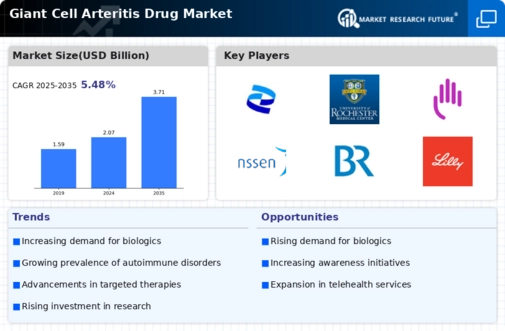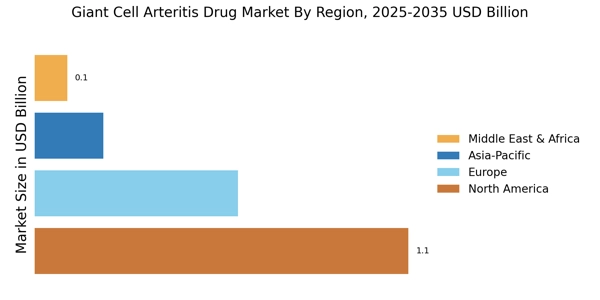Rising Healthcare Expenditure
Rising healthcare expenditure is a crucial factor driving the Giant Cell Arteritis Drug Market. Increased investment in healthcare systems allows for better access to diagnostic tools and treatment options for GCA. Countries are allocating more resources to manage chronic conditions, including GCA, which is reflected in the growing budgets for healthcare services. This trend is particularly evident in regions where healthcare reforms are being implemented to enhance patient care. As a result, the demand for effective GCA treatments is expected to rise, leading to a more competitive market landscape. The financial commitment to healthcare is likely to foster innovation and improve the availability of drugs within the Giant Cell Arteritis Drug Market.
Innovations in Drug Development
Innovations in drug development are significantly influencing the Giant Cell Arteritis Drug Market. Recent advancements in biologics and targeted therapies have shown promise in treating GCA, leading to improved patient outcomes. For instance, the introduction of monoclonal antibodies has revolutionized treatment protocols, offering alternatives to traditional corticosteroids. The market is projected to witness substantial growth, with estimates indicating a compound annual growth rate (CAGR) of over 6% in the coming years. This surge is attributed to ongoing clinical trials and research aimed at identifying novel therapeutic agents. As pharmaceutical companies invest in research and development, the availability of new drugs is likely to expand, further shaping the Giant Cell Arteritis Drug Market.
Regulatory Support for Drug Approvals
Regulatory support for drug approvals is a vital driver of the Giant Cell Arteritis Drug Market. Regulatory agencies are increasingly recognizing the need for expedited review processes for treatments targeting rare diseases, including GCA. This shift in policy is designed to encourage pharmaceutical companies to invest in research and development for GCA therapies. The introduction of programs such as orphan drug designations and fast-track approvals can significantly reduce the time it takes for new treatments to reach the market. As a result, the availability of innovative drugs is likely to increase, enhancing treatment options for patients with GCA and fostering growth within the Giant Cell Arteritis Drug Market.
Growing Patient Advocacy and Support Groups
The emergence of patient advocacy and support groups plays a significant role in the Giant Cell Arteritis Drug Market. These organizations raise awareness about GCA, educate patients on treatment options, and promote research funding. Their efforts contribute to a better understanding of the disease, which can lead to increased diagnosis rates and, consequently, a higher demand for effective therapies. Additionally, these groups often collaborate with pharmaceutical companies to facilitate clinical trials and gather patient feedback, which can influence drug development. As the patient community becomes more engaged, the market for GCA drugs is likely to expand, reflecting the needs and preferences of those affected by the condition.
Increasing Incidence of Giant Cell Arteritis
The rising incidence of Giant Cell Arteritis (GCA) is a pivotal driver for the Giant Cell Arteritis Drug Market. As the population ages, the prevalence of GCA is expected to increase, with estimates suggesting that the condition affects approximately 20 per 100,000 individuals over the age of 50. This demographic shift necessitates the development and availability of effective therapeutic options, thereby propelling market growth. Furthermore, the heightened awareness among healthcare professionals regarding the symptoms and complications associated with GCA contributes to earlier diagnosis and treatment. Consequently, this trend is likely to stimulate demand for innovative drugs, enhancing the overall landscape of the Giant Cell Arteritis Drug Market.


















Leave a Comment